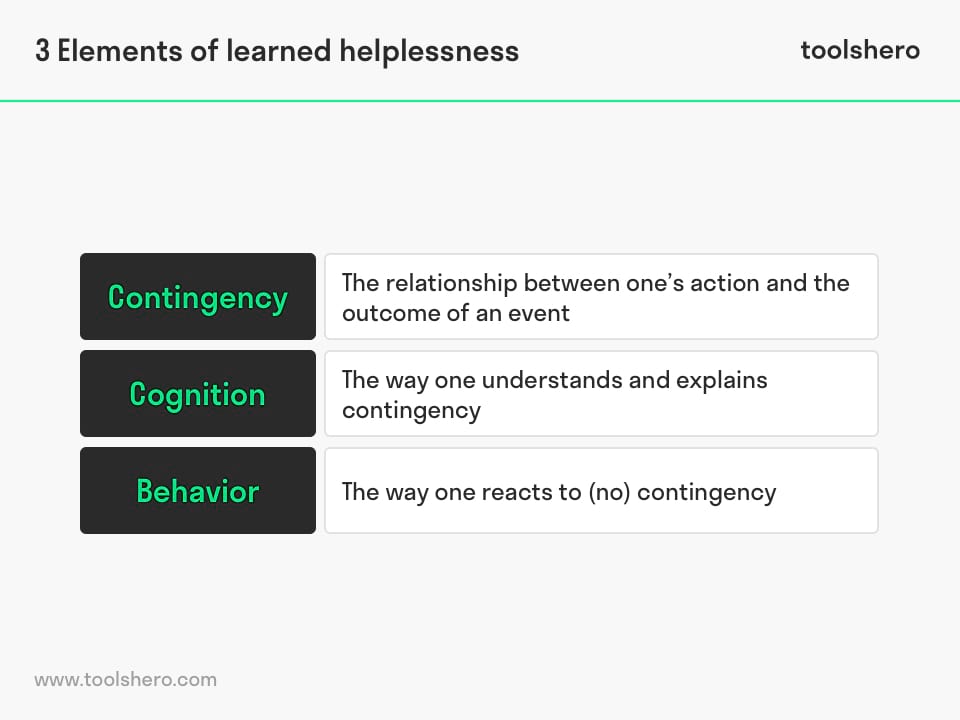Learned Helplessness Theory by Martin Seligman

Learned Helplessness Theory: this article provides a practical explanation of the Learned Helplessness Theory, developed by Martin Seligman. Next to what it is (the basic theory), this article also highlights the three elements, how to fix learned helplessness, the application of this theory and some examples. Enjoy reading!
What is the Learned Helplessness Theory?
The Learned Helplessness Theory is part of behavioral theory and has been observed in both humans and animals.
The theory explains that when a person is repeatedly exposed to uncontrollable, stressful or even painful situations, after a while that person will stop trying to control the situation or stop trying to avoid the pain even if a clear opportunity to do so becomes available.
At that point the person has learned to think and act helpless in difficult situations and will not try to change them.
People living in a state of learned helplessness accept that they go through stressful situations and that they have no control over them.
Out of fear of rejection or failure they are less likely to try new things. This could lead to more stressful feelings and can even lead to depression. For some people learned helplessness of depression is connected to post-traumatic stress disorder.
Who developed the Learned Helplessness Theory?
It was in the late 1960s, at the University of Pennsylvania when American psychologist Martin Seligman and his colleagues developed the Learned Helplessness Theory of Depression.
They conducted experimental research on dogs using electric shocks, and discovered that the dogs that were exposed to unavoidable shocks showed symptoms of depression and anxiety, while the dogs that could avoid the shocks did not.
In another research with electric shocks Martin Seligman discovered that the dogs that received the unavoidable shocks in the previous experiment made no attempt to avoid the shocks, even though this time they did have the opportunity to avoid them.
They were in a state of helplessness. Martin Seligman also recognized signs of learned helplessness with some of his clinical depressed patients and concluded that clinical depression is linked to a believed absence of control over a situation, thus learned helplessness.
He has developed three key features for recognizing learned helplessness:
- becoming passive when confronted with traumatic events
- difficulty believing that trauma can be controlled
- an increase in stress levels
What are the three elements of learned helplessness?
Learned helplessness requires at least three elements to be present.

Figure 1 – the three elements of the Learned Helplessness (Seligman)
The first element of learned helplessness is contingency, which is when a person believes that there’s a relationship between what is going on and the way they act. In the case of learned helplessness a person believes that there is no relationship between the two and therefore the way a person acts doesn’t affect what is going on.
The second element is cognition, which is the way a person understands and explains these relationships or a lack of relationships. The last element is behavior, which refers to the actions as a reaction to figuring out these relationships.
In the case of learned helplessness a person will not see a relationship between their action and the outcome of an event or situation. In that case a person will behave as if they were in an uncontrollable situation and can decide to quit.
What causes learned helplessness?
Learned helplessness can be caused by repeated traumatic experiences which usually begins during childhood. When a child needs help and the parents or other caregivers do not respond properly, the child may learn that their situation can’t be changed.
If this happens on a regular basis, learned helplessness may carry on into adulthood. For example, children who experienced continues abuse and neglect, may develop learned helplessness.
Learned helplessness can also develop during adulthood in cases of abuse, but also when a person tries to break a certain habit and repeatedly fails to do so. The feeling of not being able to control certain situations and habits can put someone in a state of learned helplessness.
It is through these experiences that people dealing with learned helplessness, believe that they are not capable of avoiding difficult situations.
They have learned to believe that they can’t control the situation and will stop trying to do so. This can affect a person’s motivation and can cause low self-esteem, frustration, passivity and a lack of effort.
Note that not everyone who experiences traumatic events or several failed attempts in trying to change a situation will develop learned helplessness. This has to do with the way a person understands and explains the relationship between the event and the person’s actions.
How to fix learned helplessness?
One common way to deal with learned helplessness is by changing the thinking and behavioral patterns that contribute to learned helplessness. This can be done through therapy such as cognitive behavioral therapy (CBT).
Through CBT you can learn how to recognize the feelings of helplessness you have during certain events and how to change your way of thinking.
Seligman developed a concept called learned optimism, which implies that people can fix learned helplessness by explaining situations to themselves in an effective way and create a positive internal dialogue.
Application of this theory
The Learned Helplessness Theory is being used within different domains of everyday life. The theory has been applied to classrooms, medical hospitals, nursing homes and psychiatric clinics.
In his first book about learned helplessness Martin Seligman suggested the application of the theory to human problems like depression, development and death. This is when the interest for research on learned helplessness started to grow.
Examples of Learned Helplessness Theory
Examples of events that could develop into learned helplessness are the following:
- When your goal is to lose weight, but no diet or lifestyle changes seem to get you there it may cause you to believe that you’ll never lose weight and you’ll stop trying.
- You want to quit smoking, but several failed attempts may cause you to believe that you’ll never stop.
- In cases of domestic abuse leaving the situation can be difficult. Even if the help is being offered, the person who’s being abused may believe that it’s impossible for them to escape their current situation.
It’s your turn
What do you think? Do you experience learned helplessness or have you experienced it before? Do you recognize what causes or has caused it? Do you recognize the explanation about the learned helplessness theory? Do you see this state of learned helplessness affecting people around you? Have you ever tried to break the a cycle of learned helplessness for yourself or someone else? Do you have any tips or additional comments?
Share your experience and knowledge in the comments box below.
More information
- Abramson, L. Y., Seligman, M. E., & Teasdale, J. D. (1978). Learned helplessness in humans: critique and reformulation. Journal of abnormal psychology, 87(1), 49.
- Maier, S. F., & Seligman, M. E. (1976). Learned helplessness: theory and evidence. Journal of experimental psychology: general, 105(1), 3.
- Peterson, C. (1982). Learned helplessness and health psychology. Health Psychology, 1(2), 153.
- Seligman, M. E. (1972). Learned helplessness. Annual review of medicine, 23(1), 407-412.
- Website ExamCollection. Retrieved 02/20/2024 from ExamCollection.com
How to cite this article:
Van Velden, E. (2020). Learned Helplessness Theory of Depression (Seligman). Retrieved [insert date] from Toolshero: https://www.toolshero.com/psychology/learned-helplessness-theory/
Original publication date: 08/10/2020 | Last update: 02/20/2024
Add a link to this page on your website:
<a href=”https://www.toolshero.com/psychology/learned-helplessness-theory/”>Toolshero: Learned Helplessness Theory of Depression (Seligman)</a>












